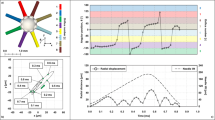Abstract
Predictive simulations of full fuel injection systems for e.g. diesel engines could be very important for reducing emissions of current engines but are still rare. Beside the numerical issues arising from discontinuities across the liquid-gas-interface, different scales relevant for the nozzle internal flow, primary breakup in the vicinity of the nozzle, and secondary breakup and evaporation further downstream make efficient simulation of the full injection system challenging. This paper introduces a multi-scale coupling approach for overcoming this issue leading to efficient and predictive injector simulations. After a brief description of the numerical methods used in this study, the coupling among nozzle internal flow, primary breakup, and secondary breakup with evaporation is introduced and analyzed with respect to computing efficiency and physical accuracy. Finally, the simulation framework is applied to the “Spray A” case of the Engine Combustion Network.
Access this chapter
Tax calculation will be finalised at checkout
Purchases are for personal use only
Similar content being viewed by others
References
Lasheras, J.C., Hopfinger, E.J.: Liquid jet instability and atomization in a coaxial gas stream. Annu. Rev. Fluid Mech. 32, 275–308 (2000)
Marmottant, P., Villermaux, E.: On spray formation. J. Fluid Mech. 498, 73–111 (2004)
Shinjo, J., Umemura, A.: Detailed simulation of primary atomization mechanisms in diesel jet sprays (isolated identification of liquid jet tip effects). Proc. Combust. Inst. 33, 2089–2097 (2011)
Gorokhovski, M., Herrmann, M.: Modeling primary atomization. Ann. Rev. 40, 343–366 (2008)
Engine Combustion Network. http://www.sandia.gov/ecn
Desjardins, O., Blanquart, G., Balarac, G., Pitsch, H.: High order conservative finite difference scheme for variable density low Mach number turbulent flows. J. Comput. Phys. 227, 7125–7159 (2008)
Desjardins, O., Moureau, V., Pitsch, H.: An accurate conservative level set/ghost fluid method for simulating turbulent atomization. J. Comput. Phys. 227, 8395–8416 (2008)
Desjardins, O., Pitsch, H.: Detailed numerical investigation of turbulent atomization of liquid jets. Atomization Sprays 20, 311–336 (2010)
Bode, M., Falkenstein, T., Pitsch, H., Kimijima, T., Taniguchi, H., Arima, T.: Numerical study of the impact of cavitation on the spray processes during gasoline direct injection. In: ICLASS 2015, 13th Triennial International Conference on Liquid Atomization and Spray Systems, Tainan, Taiwan (2015)
Germano, M., Piomelli, U., Moin, P., Cabot, W.H.: A dynamic subgrid scale eddy viscosity model. Phys. Fluids A 3, 1760–1765 (1991)
Meneveau, C., Lund, T.S., Cabot, W.H.: A Lagrangian dynamic subgrid-scale model of turbulence. J. Fluid Mech. 319, 353–385 (1996)
Le Chenadec, V., Pitsch, H.: A monotonicity preserving conservative sharp interface flow solver for high density ratio two-phase flows. J. Comput. Phys. 249, 185–203 (2013)
Le Chenadec, V., Pitsch, H.: A 3D unsplit forward/backward volume-of-fluid approach and coupling with a level set method. J. Comput. Phys. 233, 10–33 (2013)
Patterson, M.A., Reitz, R.D.: Modeling the effects of fuel spray characteristics on diesel engine combustion and emissions. SAE Trans. 107, 27–43 (1998)
Miller, R.S., Harstad, K., Bellan, J.: Evaluation of equilibrium and non-equilibrium evaporation models for many-droplet gas-liquid flow simulations. Int. J. Multiph. Flow 24, 1025–1055 (1998)
Bode, M., Falkenstein, T., Le Chenadec, V., Pitsch, H., Arima, T., Taniguchi, H.: A new Euler/Lagrange approach for multiphase simulations of a multi-hole GDI injector. SAE Paper 2015–01-0949 (2015)
Bode, M., Deshmukh, A., Kirsch, V., Reddemann, M.A., Kneer, R., Pitsch, H.: Direct numerical simulations of novel biofuels for predicting spray characteristics. In: ICLASS 2015, 13th Triennial International Conference on Liquid Atomization and Spray Systems, Tainan, Taiwan (2015)
Saddix, C.R., Zhang, J., Schefer, R.W., Doom, J., Oefelein, J.C., Kook, S., Pickett, L.M.: Understanding and prepredict soot generation in turbulent non-premixed jet flames. Report in Sandia National Laboratories (2010)
Kastengren, A.L., Tilocco, F.Z., Powell, C.F., Manin, J., Pickett, L.M., Payri, R., Bazyn, T.: Engine Combustion Network (ECN): measurements of nozzle geometry and hydraulic behalvior. Atomization Sprays 22, 1011–1052 (2012)
National Institute of Standards and Technology. http://www.nist.gov/
Engine Combustion Network Workshop 4 (2015). http://www.sandia.gov/ecn/workshop/ECN4/ECN4.php
Jülich Supercomputing Centre: JUQUEEN: IBM Blue Gene/Q Supercomputer system at the Jülich supercomputing centre. J. Large-Scale Res. Facil. 1, A1 (2015). http://dx.doi.org/10.17815/jlsrf-1-18
Acknowledgment
The authors gratefully acknowledge funding by Honda R&D and the Cluster of Excellence “Tailor-Made Fuels from Biomass”, which is funded by the Excellence Initiative of the German federal and state governments to promote science and research at German universities. Also the authors gratefully acknowledge computing time granted for the project JHPC18 by the JARA-HPC Vergabegremium and provided on the JARA-HPC Partition part of the supercomputer JUQUEEN [22] at Forschungszentrum Jülich and under grant 2013092005 of the Partnership for Advanced Computing in Europe (PRACE). Experimental data for validation has been provided by Alan Kastengren, Argonne National Laboratory, and are gratefully acknowledged, too.
Author information
Authors and Affiliations
Corresponding author
Editor information
Editors and Affiliations
Rights and permissions
Copyright information
© 2017 Springer International Publishing AG
About this paper
Cite this paper
Bode, M., Davidovic, M., Pitsch, H. (2017). Multi-scale Coupling for Predictive Injector Simulations. In: Di Napoli, E., Hermanns, MA., Iliev, H., Lintermann, A., Peyser, A. (eds) High-Performance Scientific Computing. JHPCS 2016. Lecture Notes in Computer Science(), vol 10164. Springer, Cham. https://doi.org/10.1007/978-3-319-53862-4_9
Download citation
DOI: https://doi.org/10.1007/978-3-319-53862-4_9
Published:
Publisher Name: Springer, Cham
Print ISBN: 978-3-319-53861-7
Online ISBN: 978-3-319-53862-4
eBook Packages: Computer ScienceComputer Science (R0)




